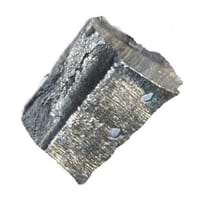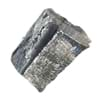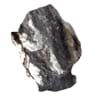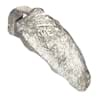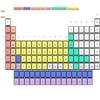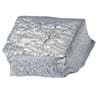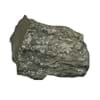Neodymium vs Iridium
Periodic Table
Symbol
Nd
Ir
Group Number
1
17
9
9
Period Number
6
6
Block
f block
d block
Element Family
Lanthanide
Transition Metal
CAS Number
7440008
99+
7439885
99+
Space Group Name
P63/mmc
Fm_ 3m
Space Group Number
194.00
5
225.00
2
Facts
Interesting Facts
- Neodymium is not found free in nature, hence it is not a native metal.
- Neodymium metal found in minerals like Monazite and Bastnaesite.
- Iridium element occurs as natural alloys of Platinum and Osmium.
- Iridium element is known as the most corrosion resistance metal .
Sources
Found in Minerals, Mining
Found in Minerals, Mining, Ores of Minerals
History
Who Discovered
Carl Auer von Welsbach
Smithson Tennant
Discovery
In 1885
In 1803
Abundance
Abundance In Universe
1 * 10-6 %
16
2 * 10-7 %
22
Abundance In Sun
~0.0000003 %
24
~0.0000002 %
25
Abundance In Meteorites
0.00 %
30
0.00 %
29
Abundance In Earth's Crust
0.00 %
20
0.00 %
99+
Abundance In Oceans
0.00 %
30
Not Available
Uses
Uses & Benefits
- Neodymium-Iron-boron alloy is used to make permanent magnets.
- It is used in microphones, Mp3 player, loudspeakers, mobile phones, etc.
- Iridium has an anti corrosion properties and it is used in special alloy with Osmium metal and that alloy is used in pen tips and compass bearings.
Industrial Uses
Aerospace Industry, Electrical Industry, Electronic Industry
Automobile Industry, Electrical Industry, Electronic Industry
Medical Uses
NA
NA
Other Uses
Alloys
Alloys
Biological Properties
Toxicity
Non Toxic
Toxic
Present in Human Body
No
Yes
Physical Properties
Melting Point
1,010.00 °C
99+
2,410.00 °C
7
Boiling Point
3,127.00 °C
28
4,527.00 °C
10
Appearance
Physical State
Solid
Solid
Color
Silvery White
Silvery White
Luster
Metallic
Metallic
Hardness
Mohs Hardness
Not Available
6.50
5
Brinell Hardness
265.00 MPa
35
1,670.00 MPa
5
Vickers Hardness
345.00 MPa
27
1,760.00 MPa
3
Speed of Sound
2,330.00 m/s
38
4,825.00 m/s
13
Optical Properties
Reflectivity
Not Available
78.00 %
6
Allotropes
No
No
α Allotropes
Not Available
Not Available
β Allotropes
Not Available
Not Available
γ Allotropes
Not Available
Not Available
Chemical Properties
Chemical Formula
Nd
Ir
Isotopes
Known Isotopes
30
9
34
5
Electronegativity
Pauling Electronegativity
1.14
99+
2.20
4
Allred Rochow Electronegativity
1.07
32
1.55
11
Allen Electronegativity
Not Available
1.68
17
Electropositivity
Pauling Electropositivity
2.86
13
1.80
99+
Ionization Energies
1st Energy Level
533.10 kJ/mol
99+
880.00 kJ/mol
9
2nd Energy Level
1,040.00 kJ/mol
99+
1,600.00 kJ/mol
35
3rd Energy Level
2,130.00 kJ/mol
99+
Not Available
4th Energy Level
3,900.00 kJ/mol
99+
Not Available
Electrochemical Equivalent
1.79 g/amp-hr
37
1.14 g/amp-hr
99+
Electron Work Function
3.20 eV
34
4.55 eV
13
Other Chemical Properties
Chemical Stability, Corrosion, Flammable, Ionization
Flammable, Ionization, Radioactive Isotopes, Radioactivity
Atomic Properties
Atomic Number
60
99+
77
39
Electron Configuration
[Xe] 4f4 6s2
[Xe] 4f14 5d7 6s2
Crystal Structure
Double Hexagonal Close Packed (DHCP)
Face Centered Cubic (FCC)
Crystal Lattice
DHCP-Crystal-Structure-of-Neodymium.jpg#100
FCC-Crystal-Structure-of-Iridium.jpg#100
Atom
Number of Protons
60
99+
74
99+
Number of Neutrons
84
40
110
27
Number of Electrons
60
99+
74
99+
Radius of an Atom
Atomic Radius
181.00 pm
13
136.00 pm
99+
Covalent Radius
201.00 pm
10
141.00 pm
99+
Van der Waals Radius
229.00 pm
20
202.00 pm
27
Atomic Weight
144.24 amu
99+
192.22 amu
34
Atomic Volume
20.60 cm3/mol
18
9.53 cm3/mol
99+
Adjacent Atomic Numbers
Valence Electron Potential
43.40 (-eV)
99+
140.00 (-eV)
5
Lattice Constant
365.80 pm
30
383.90 pm
26
Lattice Angles
π/2, π/2, 2 π/3
π/2, π/2, π/2
Lattice C/A Ratio
1.61
4
Not Available
Mechanical Properties
Density
Density At Room Temperature
7.01 g/cm3
99+
22.56 g/cm3
10
Density When Liquid (at m.p.)
6.89 g/cm3
36
19.00 g/cm3
3
Tensile Strength
Not Available
2,000.00 MPa
2
Viscosity
Not Available
Not Available
Vapor Pressure
Vapor Pressure at 1000 K
0.00 (Pa)
21
Not Available
Vapor Pressure at 2000 K
101.00 (Pa)
2
0.00 (Pa)
25
Elasticity properties
Shear Modulus
16.30 GPa
38
210.00 GPa
2
Bulk Modulus
31.80 GPa
37
320.00 GPa
3
Young's Modulus
41.40 GPa
40
528.00 GPa
1
Poisson Ratio
0.28
16
0.26
22
Other Mechanical Properties
NA
NA
Magnetic Properties
Magnetic Characteristics
Specific Gravity
7.00
99+
21.78
3
Magnetic Ordering
Paramagnetic
Paramagnetic
Electrical Properties
Electrical Property
NA
Conductor
Resistivity
643.00 nΩ·m
6
47.10 nΩ·m
99+
Electrical Conductivity
0.02 106/cm Ω
99+
0.19 106/cm Ω
10
Electron Affinity
50.00 kJ/mol
21
151.00 kJ/mol
4
Thermal Properties
Specific Heat
0.19 J/(kg K)
32
0.13 J/(kg K)
39
Molar Heat Capacity
27.45 J/mol·K
17
25.10 J/mol·K
99+
Thermal Conductivity
16.50 W/m·K
99+
147.00 W/m·K
10
Critical Temperature
Not Available
Not Available
Thermal Expansion
9.60 µm/(m·K)
99+
6.40 µm/(m·K)
99+
Enthalpy
Enthalpy of Vaporization
273.00 kJ/mol
34
799.10 kJ/mol
1
Enthalpy of Fusion
7.14 kJ/mol
99+
35.23 kJ/mol
1
Enthalpy of Atomization
322.00 kJ/mol
32
837.00 kJ/mol
1
Standard Molar Entropy
71.50 J/mol.K
13
35.50 J/mol.K
99+
|
||
|
||
|
